 Image search results - "moriyama" Image search results - "moriyama" |

Road marker. Established in 1642, Moriyama-juku was the sixty-seventh of the sixty-nine stations or shukuba post towns on the Nakasendo Road. It is the eighth Nakasendo station in Shiga (following Musa-juku in Omi-Hachiman).
|
|

Road marker. Go right for the Nakasendo Road. MAP
|
|

Rear of road marker
|
|

Marker for the Kabuto-ya inn
|
|

Old Nakasendo Road and Dobashi Bridge. Supposedly, this is the bridge from where Hiroshige drew his print of Moriyama-juku.
|
|

Dobashi Bridge
|
|

Tomon-in temple built by Buddhist Priest Saicho (Dengyo Daishi) to protect his Enryakuji temple on Mt. Hiei from demons from the east. 東門院
|
|

Kaeru frog to wish you a safe return. 東門院
|
|

樹下神社
|
|

Entrance to Iimoriyama Hill, site of the Byakkotai "White Tiger" Battalion gravesite. In 1868, a unit of teenage warriors called Byakkotai (White Tiger Battalion) fought against the Emperor-backed Imperial forces encroaching their domain of Aizu
|
|

Sumiyoshi Shrine is on the west side of JR Moriyama Station. This side has an area called "Fuke" written with the same kanji for "uwaki" (cheating on your partner).I wonder what married couples think of living in this area...
|
|
|

The Byakkotai were outnumbered and forced to retreat. Twenty of them escaped to Iimoriyama Hill where they saw what looked liked a burning Tsurugajo Castle. Photo: Pay a small fee to take the escalator up the hill. Or climb up the steps for free.
|
|

Sumiyoshi Shrine torii. Notice the torches inside the shrine. 住吉神社 MAPEvery Jan., both this shrine and Katsube Shrine light giant torches for the festival's climax. Unfortunately, you cannot see the festival at both shrines since they are held around the same time. Sumiyoshi Shrine's fire festival is smaller with fewer (six) torches which represent the head of the slain dragon.
|
|
|

In despair, the boys decided to kill themselves rather than die in the hands of the enemy. Photo: Escalator to go up Iimoriyama Hill.
|
|

Sumiyoshi Shrine and the six giant torches.
|
|

Stone for safe childbirth
|
|

Escalator to go up Iimoriyama Hill. Their tombstones are on this hill near where they killed themselves. Their story has become legend.
|
|

Sumiyoshi Shrine and the six giant torches.
|
|

Tenmangu Shrine
|
|

Byakkotai Gravesite. It is on a flat area which also has several other Byakkotai monuments including those from other countries.
|
|

Side view of torches.
|
|

Tenmangu Shrine
|
|

Approach to the Byakkotai gravesite.
|
|

Head of torch. Different shape from Katsube Shrine's torches.
|
|
|

Torch stem
|
|

Graves of the 19 teenage Byakkotai warriors who killed themselves with their own swords.
|
|

Straw-covered torches.
|
|

Byakkotai Graves
|
|

Torches are bunched together.
|
|

Byakkotai Graves
|
|
|

Byakkotai gravestones. Each one shows the name, age, and method of death called "jijin" (died with one's own sword 自刃).
|
|
|
|
|
|

This has become a national shrine, almost as important as Sengakuji where the 47 masterless samurai are buried.
|
|
|
|
|
|
|

Back of the torch heads.
|
|
|
|
|

On the right side are more gravestones. These are 31 Byakkotai members who died in battle. 戦死
|
|
|

Tombs of those Byakkotai who died in action.
|
|
|

Tombs of those Byakkotai who died in action.
|
|

Sumiyoshi Shrine
|
|

Their names, age, and "senshi" 戦死 (died in battle) are engraved on the stones.
|
|

Men in loincloths beat the wall in a building, then came out with small torches.
|
|
|

First man lights the giant torches. This was around 7:45 pm.
|
|

Monument for teenage samurai who died in battle.
|
|

More men light the torches. The straw ignited almosty immediateely and no kerosene was used.
|
|

Names of Byakkotai members, all 14 to 17 years old.
|
|

The torches burn within seconds.
|
|

On the left of the gravestones, there is a monument for a poem composed by Lord Matsudaira Katamori, the last Aizu lord and whom the Byakkotai died for. 幾人の 涙は石にそそぐとも その名は世々に 朽じとぞ思う幾人の 涙は石にそそぐとも その名は世々に 朽じとぞ思う
Ikutari no namida wa ishi ni sosogu tomo sono na wa yoyo ni kuji to zo omou
"No matter how many people pour their tears on these stones, these names will never fade from the world."
|
|

Sumiyoshi Shrine Fire Festival
|
|

A short walk away is the grave of Iinuma Sadakichi, the only Byakkotai survivor who had slit himself, but was rescued by a villager passing by when everyone else had killed themselves.
|
|

The fire at its peak was very hot to the skin. Sumiyoshi Shrine Fire Festival, Moriyama, Shiga in late Jan.
|
|

Grave of Iinuma Sadakichi, the only Byakkotai warrior who survived and told the story of this valiant teenage group.
|
|
|

Grave of Iinuma Sadakichi (Sadao) (1854-1931). His grave was built here in 1957 for the 90th anniversary of the Byakkotai's demise. 飯沼貞吉
|
|

The torches burnt out within a few minutes.
|
|

About Iinuma Sadakichi (later changed his first name to Sadao)
|
|
|

Slope where they committed seppuku (hara-kiri). 自刃の地
|
|
|

Site where they committed seppuku (hara-kiri). 自刃の地
|
|

Before the torches burnt out completely, the men hauled away each torch one by one.
|
|
|

Sumiyoshi Shrine Fire Festival, Moriyama, Shiga Pref. on the second Sat. of January.
|
|
|
|
|
|

Taming the firre.
|
|
|
|

Great way to warm up.
|
|
|
|
|
|

The festival ended quickly. A lot faster than the Katsube Shrine's Fire Festival held at the same time.
|
|

A recent addition is this statue of a teenage samurai looking at Wakamatsu Castle.
|
|

Fire hydrant and hose just in case.
|
|

Statue of a teenage samurai looking at Wakamatsu Castle.
|
|

Fire truck and burnt torch.
|
|
|

Statue faces Tsuruga-jo Castle which can be seen in the distance.
|
|

Arrow points to Tsuruga-jo Castle.
|
|
|

Byakko Kannon statue
|
|
|
|
|

Monument from Rome, Italy, given in 1928 by Mussolini. The column is from the ruins of a palace in Pompeii.
|
|

Monument message in Italian. After WWII, the US Occupation authorities wanted this monument removed. But all they did was remove the engraved message (later restored).
|
|

About the monument from Rome.
|
|

Monument from a German, Hasso von Etzdorf (1900 - 1989).
|
|

Another monument
|
|

Opened in 1956, the Byakkotai Memorial Museum has numerous artifacts related to the Byakkotai as well as the Shinsengumi. Photography inside is not allowed. Admission 400 yen.
|
|

Byakkotai statue outside the Byakkotai Memorial Museum
|
|
|
|

Uga Shrine 宇賀神社
|
|

Byakkotai enshrined in Uga Shrine
|
|

Painting depicting Byakkotai suicide on Iimoriyama Hill
|
|

Sazaedo, a unique wooden, hexagonal structure which you will see when coming down from Iimoriyama.
|
|

Sazaedo
|
|

Sazaedo
|
|

Sazaedo
|
|
|
|

Byakkotai souvenirs
|
|

Daughter Sagawa from Moriyama.
|
|
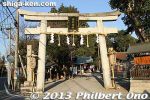
The Katsube Shrine Fire Festival is held annually on the second Sat. of January. They light 12 giant straw torches with young men dancing around. The shrine is near JR Moriyama Station (JR Tokaido/Biwako Line). This is the shrine's main o-torii gate. MAP
|
|
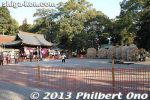
Katsube Shrine and giant torches. Six torches were laid within the shrine grounds. I saw the festival twice, in 2006 and 2013.
|
|
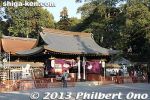
Katsube Shrine in Moriyama, Shiga Prefecture. The Honden main hall behind the building you see here is an Important Cultural Property.
|
|

Rear view of torches.
|
|

Katsube Shrine was founded in 649 and originally dedicated to a warrior god by the Mononobe clan.
|
|

Poster recruiting torch/taiko drum men aged 13-34 to carry the taiko drums and giant torches on the day of the fire festival.
|
|
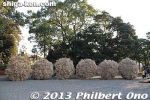
According to legend, 800 years ago during the Kamakura Period, Emperor Tsuchikado fell ill. A fortune-teller said that it was due to a monster orochi dragon in the marsh in the area of present-day Moriyama.
|
|
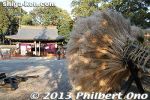
The emperor sent hunters to kill the dragon which they finally did and burned the body. The emperor then recovered from his illness. When the dragon was burned, the body fell on Katsube Shrine while the head fell on Sumiyoshi Shrine.
|
|
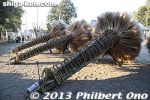
Both Katsube Shrine and Sumiyoshi Shrine hold a fire festival on the same day and same time so you cannot see both fire festivals on the same day.
|
|
|
|
|
|
|
|
|
|
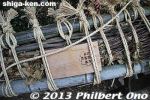
These little pieces of wood symbolize the scales of the orochi dragon.
|
|
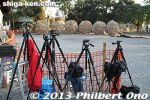
Photographers stake their place hours before the festival started. The prime viewing spots were already taken by 4 pm.
|
|
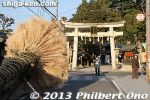
Six more torches were right outside Katsube Shrine. They will be carried into the shrine one by one to be burned.
|
|
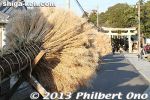
A total of 12 giant torches would be lit up for the festival. In the old days, they had more torches, but the number has decreased due to the difficulty of procuring materials.
|
|
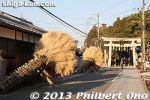
The torches are made of tree branches, bamboo, and straw from rapeseed hulls. Many people are involved in gathering the materials and making the torches.
|
|
|
|
|
|
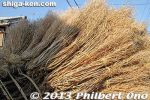
Some 400 bundles of rapeseed hulls are used for the 12 torch heads. The torch head smells like tatami mat.
|
|
|
|
|
|
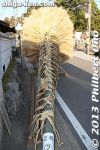
The torches are about 5 meters long and weigh over 400 kg.
|
|
|
|
|
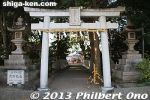
Katsube Shrine torii.
|
|
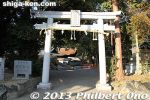
Another Katsube Shrine torii.
|
|

At 6 pm, half-naked young men wearing loincloths march to the shrine. They are 15-34 years old. 迎え
|
|
|
|

Prayer ceremony at Katsube Shrine before they start parading with three taiko drums. 修祓式(しゅっぱつしき)
|
|
|

Taking a sip of sacred sake. They soon get pretty drunk with sacred sake as they walk around the neighborhood beating the taiko drum.
|
|
|
|
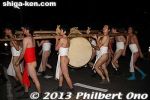
The taiko men parade around the neighborhood from about 6:15 pm to 7:50 pm. (たいこ わたり 太鼓渡り)
|
|

Taiko drum procession. Three taiko drums are carried around the neighborhood.
|
|
|

At around 8 pm, the three taiko drums return to Katsube Shrine (たいこ みやいり 太鼓宮入り)
|
|
|
|
|
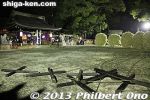
In the foreground are torch stands, partially burnt.
|
|
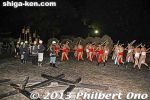
All the Torch and taiko drum bearers (たいまつぐみ 松明組) and helpers (せわかた 世話方) now line up in front of the shrine to receive sacred sake (おみき お神酒) and a good-luck charm (おふだ お札).
|
|
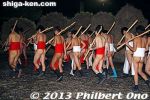
They all carry a shushi stick imprinted with "Prayer for family safety and health" (奉納勝部神社 家内安全 かない あんぜん).
|
|
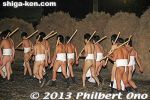
The older men wear red loincloths and the younger ones wear white.
|
|
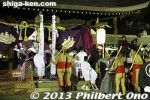
The men receive sacred sake and a good-luck charm from a shrine priest. The ceremony is called, Shushi-mairi (しゅうしまいり 牛玉参り).
|
|
|
|

The waiting crowd.
|
|

One torch enters the shrine. At around 8 pm, the young men start hauling in the giant torches that were displayed in the neighborhood.
|
|

One of the six torches carried into the shrine.
|
|
|
|
|
|
|
|

A total of 12 torches are then in the shrine.
|
|

Giant torches in Katsube Shrine, Moriyama, Shiga Pref.
|
|
|

They turned off all the lights and lit the torches all at once! Torch lighting! (たいまつ ほうか 松明奉火)
|
|

It gets very hot...
|
|

Katsube Fire Festival: Men dance in rings in front of the fire. Also see the video at YouTube.
|
|
|
|
|

After a few minutes and before it gets unbearably hot, the fire peters out.
|
|
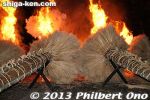
Rear view of burning torches.
|
|
|
|
|
|
|
|
|
|
|
|
|

The giant torches burnt out within 10 minutes.
|
|

Withdrawing the burnt-out torch
|
|

My video of the Katsube Shrine Fire Festival on Jan. 12, 2013. Three Japanese kids report in English.
|
|

Withdrawing the burnt-out torch
|
|
|

You can take home a branch of the torch for family safety.
|
|
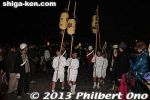
The lantern bearers lead the way as the taiko drum bearers exit the shrine.
|
|
|

Shrine worshippers
|
|

Snuffing out the last flames
|
|
|

All fires totally fizzled out.
|
|

Local firemen
|
|

Fire truck and hydrant right outside the shrine.
|
|
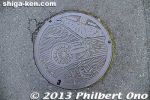
Moriyama manhole, Shiga Pref.
|
|

The Shiga Lakestars played against Osaka Evessa on Oct. 24-25, 2009 at Moriyama Shimin Taiikukan gym, a short bus ride from Moriyama Station. Special shuttle buses ran from the station to the gym.
|
|

Path to the gym entrance is lined with Lakestars banners.
|
|

Outside the gm entrance is this food stand selling Bobby Nash's Locomoco (sunny-side up egg on a hamburger on a bowl of rice) and team captain Fujiwara Takamichi's curry rice.
|
|

Moriyama gym entrance.
|
|

Door to the Moriyama gym.
|
|

Entrance lobby is decorated with player cutouts. We had to take off our shoes when entering the Moriyama gym. Slippers were provided.
|
|

Official Shiga Lakestars merchandise.
|
|

Cheerleaders perform.
|
|

Introduction of Osaka Evessa players.
|
|

Introduction of Shiga Lakestars players.
|
|

Head coach Robert Pierce chats with an ardent fan in a wheelchair.
|
|

Introduction of starting five. This is Luke Zellar.
|
|

Tip-off at about 5 pm between the Shiga Lakestars and Osaka Evessa.
|
|

Wara tries for one.
|
|

Mike Hall #23 with the ball.
|
|

View from upper level for free seating costing 1,800 yen (advance tickets).
|
|

Luke Zellar #40 rises to the occasion.
|
|

Fujiwara Takamichi #11, team captain. Nickname is "Wara."
|
|

Luke Zellar #40 for a free throw.
|
|

Many homemade banners cheering the Lakestars.
|
|

Fujiwara Takamichi #11
|
|

Fujiwara Takamichi #11 for a free throw.
|
|

Kojima Yuta #03 going up.
|
|

Osaka Evessa proved to be a strong team as the score went neck to neck throughout the game. The Lakestars managed to keep up with Evessa even after falling behind a few times.
|
|

Gary Hamilton #2
|
|

Evessa head coach Tennichi Kensaku (center) talks to his team during a timeout.
|
|

Kojima Yuta #03 passing the ball.
|
|

Fujiwara Takamichi #11
|
|

Osaka provided an exciting game as the score kept see-sawing between the two teams.
|
|

Ogawa Shinya #5
|
|

Chris Schlatter #4
|
|

Joho Masashi #31 trying the keep the ball away from the long arm of an Evessa player.
|
|

Shiga Lakestars Joho Masashi #31
|
|

Gary Hamilton #2
|
|

Mike Hall #23
|
|

Joho Masashi #31. During this game, I got a lot of good shots of Joho.
|
|

Magnee, official mascot, and Lakestars cheerleaders.
|
|
|
|
|
|

Horikawa Ryuichi #8 looking for someone.
|
|
|
|
|